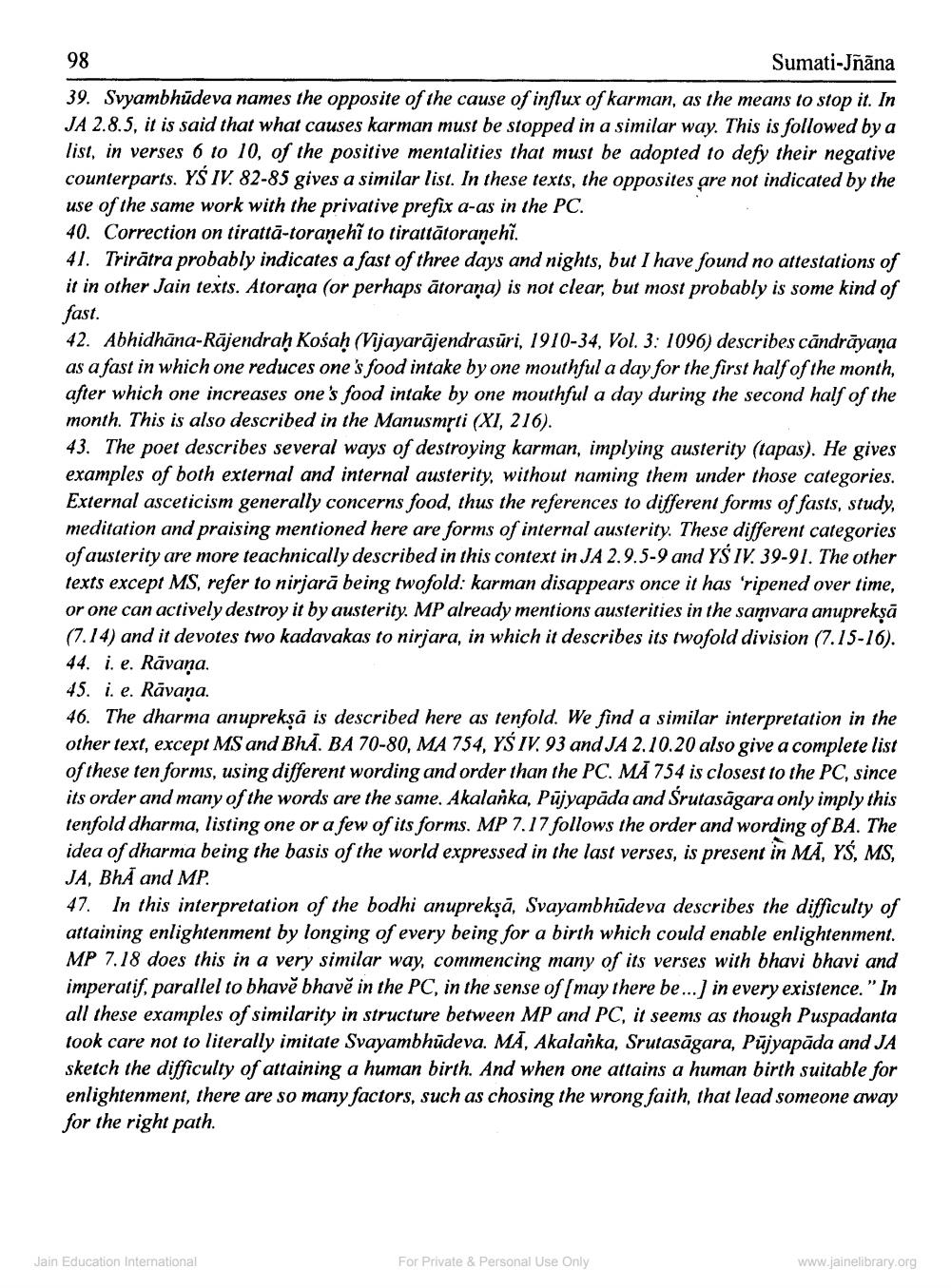________________
98
Sumati-Jñāna 39. Svyambhudeva names the opposite of the cause of influx of karman, as the means to stop it. In JA 2.8.5, it is said that what causes karman must be stopped in a similar way. This is followed by a list, in verses 6 to 10, of the positive mentalities that must be adopted to defy their negative counterparts. YŚ IV. 82-85 gives a similar list. In these texts, the opposites are not indicated by the use of the same work with the privative prefix a-as in the PC. 40. Correction on tirattā-toranehỉ to tirattātoraņehi. 41. Trirätra probably indicates a fast of three days and nights, but I have found no attestations of it in other Jain texts. Atorana (or perhaps ātorana) is not clear, but most probably is some kind of fast. 42. Abhidhāna-Rājendraḥ Kośaḥ (Vijayarājendrasūri, 1910-34, Vol. 3: 1096) describes cāndrāyana as a fast in which one reduces one's food intake by one mouthful a day for the first half of the month, after which one increases one's food intake by one mouthful a day during the second half of the month. This is also described in the Manusmrti (XI, 216). 43. The poet describes several ways of destroying karman, implying austerity (tapas). He gives examples of both external and internal austerity, without naming them under those categories. External asceticism generally concerns food, thus the references to different forms of fasts, study, meditation and praising mentioned here are forms of internal austerity. These different categories of austerity are more teachnically described in this context in JA 2.9.5-9 and YŚ IV. 39-91. The other texts except MS, refer to nirjarā being twofold: karman disappears once it has 'ripened over time, or one can actively destroy it by austerity. MP already mentions austerities in the samvara anupreksā (7.14) and it devotes two kadavakas to nirjara, in which it describes its twofold division (7.15-16). 44. i. e. Rāvaņa. 45. i.e. Rāvana. 46. The dharma anuprekşā is described here as tenfold. We find a similar interpretation in the other text, except MS and BhĀ. BA 70-80, MA 754, YŚ IV. 93 and JA 2.10.20 also give a complete list of these ten forms, using different wording and order than the PC. MĀ 754 is closest to the PC, since its order and many of the words are the same. Akalanka, Pujyapāda and Śrutasagara only imply this tenfold dharma, listing one or a few of its forms. MP 7.17 follows the order and wording of BA. The idea of dharma being the basis of the world expressed in the last verses, is present in MĀ, YS, MS, JA, BhA and MP. 47. In this interpretation of the bodhi anuprekşā, Svayambhūdeva describes the difficulty of attaining enlightenment by longing of every being for a birth which could enable enlightenment. MP 7.18 does this in a very similar way, commencing many of its verses with bhavi bhavi and imperatif, parallel to bhavě bhavě in the PC, in the sense of (may there be ...) in every existence." In all these examples of similarity in structure between MP and PC, it seems as though Puspadanta took care not to literally imitate Svayambhūdeva. MA, Akalanka, Srutasāgara, Pujyapāda and JA sketch the difficulty of attaining a human birth. And when one attains a human birth suitable for enlightenment, there are so many factors, such as chosing the wrong faith, that lead someone away for the right path.
Jain Education International
For Private & Personal Use Only
www.jainelibrary.org




